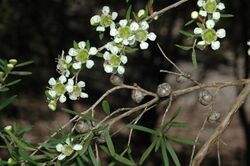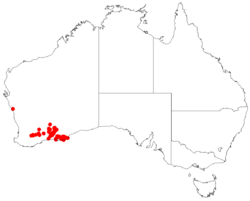Biology:Leptospermum incanum
| Leptospermum incanum | |
|---|---|

| |
| In the Australian National Botanic Gardens | |
| Scientific classification | |
| Kingdom: | Plantae |
| Clade: | Tracheophytes |
| Clade: | Angiosperms |
| Clade: | Eudicots |
| Clade: | Rosids |
| Order: | Myrtales |
| Family: | Myrtaceae |
| Genus: | Leptospermum |
| Species: | L. incanum
|
| Binomial name | |
| Leptospermum incanum Turcz.[1]
| |

| |
| Occurrence data from AVH | |
Leptospermum incanum is a species of compact shrub that is endemic to Western Australia. It has hairy young stems, elongated egg-shaped leaves on a short petiole, relatively large white or pink flowers and fruit that fall from the plant when mature.
Description
Leptospermum incanum is a compact shrub that typically grows to a height of 1–3 m (3 ft 3 in–9 ft 10 in) with peeling bark on the older branches and younger stems with soft, fine hairs pressed against the surface. The leaves are an elongated egg shape, mostly about 15 mm (0.59 in) long and 2–5 mm (0.079–0.197 in) wide. The flowers are white or pink, 10–15 mm (0.39–0.59 in) wide and are borne singly or in pairs on short side shoots. The floral cup is about 3 mm (0.12 in) long and is covered with flattened silky hairs on a pedicel 3–5 mm (0.12–0.20 in) long. The sepals are triangular, about 1–2 mm (0.039–0.079 in) long, the petals about 5 mm (0.20 in) long and the stamens 1.5–2.5 mm (0.059–0.098 in) long. Flowering occurs from July to December and the fruit is a capsule 3–3.5 mm (0.12–0.14 in) long with the remains of the sepals attached, but that falls from the plant after the release of the seeds.[2][3]
Taxonomy and naming
Leptospermum incanum was first formally described in 1852 by Nikolai Turczaninow in the Bulletin de la Classe Physico-Mathématique de l'Académie Impériale des Sciences de Saint-Pétersbourg from material collected by James Drummond.[4][5] The specific epithet (incanum) is a Latin word meaning hoary.[6]
Distribution and habitat
This tea-tree is found among granite outcrops between Coolgardie and the south coast of Western Australia where it grows in sandy soils in the Avon Wheatbelt, Coolgardie, Esperance Plains and Mallee biogeographic regions.[2][3]
Conservation status
Leptospermum incanum is classified as "not threatened" by the Western Australian Government Department of Parks and Wildlife.[2]
References
- ↑ "Leptospermum incanum". https://biodiversity.org.au/nsl/services/apc-format/display/98610. Retrieved 6 April 2020.
- ↑ 2.0 2.1 2.2 "Leptospermum incanum". FloraBase. Western Australian Government Department of Parks and Wildlife. https://florabase.dpaw.wa.gov.au/browse/profile/5849.
- ↑ 3.0 3.1 Thompson, Joy (1989). "A revision of the genus Leptospermum (Myrtaceae)". Telopea 3 (3): 377.
- ↑ "Leptospermum incanum". APNI. https://id.biodiversity.org.au/instance/apni/524686. Retrieved 6 April 2020.
- ↑ Turczaninow, Nikolai (1852). "Myrtaceae Xerocarpicae in Nova Hollandia a cl. Drummond lectae et plerumque in collectione ejus quinta distributae, determinatae et descriptae.". Bulletin de la Classe Physico-Mathématique de l'Académie Impériale des Sciences de Saint-Pétersbourg 10: 335. https://www.biodiversitylibrary.org/item/173046#page/418/mode/1up. Retrieved 6 April 2020.
- ↑ Francis Aubie Sharr (2019). Western Australian Plant Names and their Meanings. Kardinya, Western Australia: Four Gables Press. p. 223. ISBN 9780958034180.
Wikidata ☰ Q15369017 entry
 |

